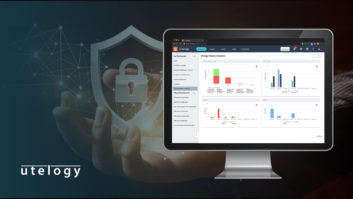Transport hubs, with airports at the forefront, are becoming ‘innovative testbeds’ for data-driven, connected and customer-centric displays. The speed of change is dizzying as technological advances, allied to public demand for a better experience, drive global trends. The integration of the technology with infrastructure, operations and customer flows is deeper than ever before. And it’s not just the use of displays that is evolving. Audio, although playing second fiddle to signage, is a vital part of the story.
Sean Wargo, vice president of market insight, AVIXA, says: “The biggest trend is the increasing adoption of digital signage in transportation, putting this market near the top of the list of buying segments for signage, along with retail and hospitality. Think about any transportation hub these days – signage is a key component of the traveller experience, with wayfinding, travel information, advertising, and QSR interactions. Signage has even allowed branding and artistic installations in hubs, all to improve and enhance the travel experience.”

TRULY GLOBAL
Previously restricted to larger hubs in wealthier cities, the move to creating connected, customer-centric digital signage in transportation is now truly global, according to Mikael Varga, sales manager, ZetaDisplay. He says: “From India’s bustling railway stations, where AI-powered displays deliver real-time updates and targeted content to millions daily, to Bangkok’s ultra-modern MRT and airport terminals, where high-resolution LED walls enhance both wayfinding and retail experiences, digital signage is accelerating worldwide.”
The dynamism in the sector is inspiring transport hubs to double as “innovative testbeds” for data-driven displays, Varga argues. “At Oslo Central Station and aboard Flytoget, Norway’s Airport Express Train, ZetaDisplays intelligent signage platforms help communicate time-sensitive updates to thousands of passengers daily,” he says. “This ensures smooth transitions and maintains Flytoget’s top-tier customer satisfaction ratings. Similarly, on Hurtigruten’s coastal ferry fleet, our screens not only inform but immerse travellers in Norway’s dramatic landscapes.”
DEEPER INTEGRATION
Varga says the goal in every project now is to achieve a deeper integration of technology with infrastructure, operations and customer flows. An example is the company’s installation of more than 250 screens for Arlanda Express, Sweden’s airport rail link. He explains: “Our Engage CMS platform forms the brain of these systems. It facilitates real-time updates, integrates with live departure data, and ensures each piece of content is relevant to the location, audience, and time of day. At Oslo Airport’s Tanum bookshop, our bespoke integration between Engage and the departure boards allows dynamic promotions of travel guides matched to flight destinations.”
The type of transportation strongly impacts the AV technology deployed, according to Craig Sholder, director of sales for the west coast and transportation sector, SNA Displays. Airports are at the forefront of the revolution. They have embraced advanced video walls, multilingual dynamic signage, biometric check-ins, and immersive technology. Adjacent services, such as onsite rentals using LED video walls to attract customers, mirror developments in the wider retail world. “For example, car rental company SIXT upgraded its in-person customer service experience at Hartsfield-Jackson Atlanta International Airport with an SNA Displays’ 43ft video wall that spans the length of its customer service counter to immerse guests in content and messaging,” Sholder adds.
For train and metro stations, the emphasis is more on installing rugged AV hardware for high traffic environments. These hubs integrate LED video displays with scheduling systems and accessibility enhancements like audio loops and real-time voice announcements. “Busy and distracted commuters rely on dynamic, eye-catching digital signage to provide important information,” Sholder observes. “For example, as part of an extensive revitalisation project to New York’s Penn Station, Amtrak added a 37ft LED video screen from SNA Displays to enhance wayfinding, improve communication, and create a more attractive commuting environment.”

Finally, bus depots or ferry terminals are adopting large-format digital, but the speed of change is somewhat slower because of budgetary and spatial limitations. These video displays often serve to welcome guests at the terminal and advertise local shopping and attractions. Sholder comments: “The LED video at Nassau Cruise Port in the Bahamas is a perfect example of digital signage that incorporates wayfinding and community-messaging while also serving a critical role for the local economy.”
UNDER PRESSURE
Under pressure to match, or surpass, rival hubs, decision-makers are clamouring to stay abreast of the latest tech advancements. Pierre Gillet, vice president of international sales at BrightSign, says: “Decision makers within these large transport hubs are desperate to keep up-to-date. Dynamic digital signage contributes to the general look and feel of hubs, not to mention ease of navigation and the hub’s overall reputation. As a result, transport hubs of all sizes are evaluating how they can implement digital signage at all levels, with smaller hubs looking at new greenfield deployments as the value of digital signage becomes increasingly hard to ignore.”
Transportation companies also recognise the potential benefits for their advertising strategies. By capitalising on high-traffic environments, new revenue streams can be generated by promoting ancillary services and leveraging passenger dwell time. Gillet adds: “Digital signage allows for dynamic and targeted advertising, enabling operators to sell advertising space to a wide range of businesses looking to reach a captive audience. Programmatic advertising capabilities further enhance revenue generation by ensuring advertisements are relevant to the location, time of day, and demographics. There may be opportunities to upsell related services or promote loyalty programmes.”
AUDIO ADVANCES
A similar state of flux characterises the evolution of audio solutions in transportation centres from basic analogue to flexible and scalable digital systems. Matt Czyzewski, executive vice president, AtlasIED, says hubs now want the audio to be integrated into networked systems to improve communication and situational awareness. AtlasIED’s GLOBALCOM platform is in demand at transport hubs, Czyzewski says, precisely because it has been designed to facilitate networkable digital communication. An example, he says, is at Newark Airport’s new Terminal A, which features immersive multimedia and real-time paging through more than 2,300 loudspeakers.
“Transport hubs are often expanded or renovated over time, requiring easily scalable AV infrastructure. Interoperability is another crucial requirement as systems must integrate seamlessly with fire alarms, security systems, and other building management tools,” Czyzewski comments. “At Newark Terminal A, the GLOBALCOM platform facilitates intelligent audio distribution, emergency integration, and automated sound levelling. The deployment included over 120 digital paging stations and 48 smart amplifiers with backup channels, ensuring fault-tolerant communication within this dynamic, high-traffic environment.”

Just as in the case of digital signage, the type of audio installation depends on the mode of transportation. Shannon Humphrey, president of loudspeaker provider SoundTube Entertainment, says airports need clear announcements over large, acoustically complex areas, while metro systems require more rugged, vandal-proof solutions. Despite these differences, much of the technology is the same for both. “Audio technology has significantly shifted from analogue systems to digital, networked solutions like Dante-enabled PoE speakers, improving audio clarity, zoning flexibility, and remote management,” Humphrey adds.
Compelled by a desire to be inclusive as well as by regulatory pressures, transport hubs are paying more attention to the quality of assistive audio. Ampetronics | Listen Technologies, a provider of hearing loop and assistive listening solutions, is seeing rising demand, according to Jonathon Hoskin, technical sales engineer. He argues that transport environments are moving from passive infrastructure to interactive, digitally inclusive spaces. As a result, there is more focus on deploying use-controlled access to personalised information, as well as on integration with smart mobility platforms and accessible technology.
To fulfill all these needs, Hoskin says Ampetronic is deploying Auri, an assistive listening system that uses Auracast broadcast audio technology. “Auracast is a natural next step – moving from traditional broadcasting to targeted ‘narrowcasting’. It empowers passengers to access the audio they need, when and how they need it, using their familiar devices. We believe it will soon become a standard accessibility feature, just as hearing loops have been for decades,” he says.
INTEGRATOR INNOVATION
Some of the keenest observers of technology developments are, of course, the integrators who face pressure to modernise the hubs effectively. Their solutions are often innovative and bespoke. The Belgian integrator TVV Sound Project, for example, was tasked with updating the public address system at Liège train station with “the latest technologies”. The solution was to deploy the Dante protocol and loudspeaker systems from Active Audio and APG, which are controlled with beam-steering technology via Powersoft amplifiers. The amplifiers are integrated into the railway company Infrabel’s existing network.
Edo Dijkstra, CEO, TVV Sound Project, says: “The installation market for transportation is evolving toward specialised techniques, both digitally and aesthetically. Standard installation methods are becoming less acceptable. This trend ensures installations are not only functional, but also innovative and aligned with technological developments. Digital technologies are becoming more important, such as new Class D amplifiers and Dante audio. They offer higher quality and efficiency, as well as improved system control, allowing IT departments in transport hubs to respond quickly to technical issues.”
When hubs choose to upgrade technology, an important evaluation criteria is the ability to integrate with other systems. Matt Czyzewski, at AtlasIED, says the company’s GLOBALCOM platform uses IP-based architecture to communicate directly with fire alarm systems, security networks, digital signage, and building management platforms to create a coordinated and intelligent environment. This interconnected approach is crucial in high-stakes environments like airports, Czyzewski argues, as timing, clarity, and system interoperability are essential. “At Newark Terminal A, the GLOBALCOM system was integrated with the fire alarm system so that only authorised communication points remain active during an emergency while regular paging is suppressed. This coordination helps prevent confusion and ensures that safety protocols are followed in real-time. Programmable relay modules and digital stations allow for localised control without compromising the integrity of the central system,” Czyzewski explains.
In a similar vein, Dan Verbsky, senior transportation account manager, LG Electronics, says the company’s digital display solutions are designed for integration with third-party CMS platforms and smart transportation systems. “A prime example is our work at Portland International Airport (PDX), where we modernised the flight information display system while eliminating the complexity of external media players and reducing the risk of network vulnerabilities. SITA’s display engine was optimised for LG’s webOS, enabling direct delivery of content over Ethernet with no additional devices needed. This integration simplifies workflows and enhances system-wide responsiveness. Whether for wayfinding, multilingual messaging, or internal operational guidance, our displays act as a connective layer between data and the public, enhancing both visibility and usability.”

INTEROPERABLE AV
Modern AV solutions need to be interoperable with building management systems (BMS) for centralised control of lighting, HVAC, as well as smart rooms and conference room management, according to Craig Sholder, at SNA Displays. And the Internet of Things (IoT) allows sensors to trigger AV alerts, for example, to steer passengers away from crowded areas, or signal poor air quality. Meanwhile, mobile apps and wearables create omnichannel communication with travellers. “The goal for these infrastructure upgrades is a holistic, data-driven ecosystem rather than siloed AV components,” Sholder says.
Given the speed of change and the desire for interoperability, modular systems are in demand as components can be swapped out more readily. Simon Hayes, director of transportation, Sharp NEC Display Solutions, says the company’s modular, adaptable hardware is designed to be compatible with any airport infrastructure or content management system (CMS). “The modular design of our large format displays is appreciated for its future-proof capabilities, which allow the integration of the most appropriate computing technology to suit the needs of the application and are upgradable without having to replace the entire display,” he explains.
Clearly, all this new technology requires major financial commitments, which may be undermined by wider economic factors. Overall the travel sector has surged back since the COVID19 shutdowns and even exceeds pre-pandemic levels. But Sean Wargo at AVIXA cautions that tariffs and other costs can act as headwinds to investments in the front-of-house traveller experiences. “The biggest threat though would be a recession or consumer retrenchment that undercuts travel as a whole, thereby putting a limit on resources,” he adds.
Most manufacturers, however, remain optimistic about the AV transportation market. Shannon Humphrey, at SoundTube, describes it as generally strong, despite tariffs issues and supply-chain challenges. “Rising costs of materials and shipping have required us to adopt proactive measures. At SoundTube, we’ve responded by sourcing materials strategically, prioritising US-made products to reduce tariff impacts, and managing inventory flexibly. This approach helps us stay competitive without sacrificing quality or availability,” she says.
OPPORTUNITY KNOCKS
The most optimistic appraisal of the market comes from Neil Hahn, the vice president of Hahn Integrated Systems, a consultant on the US$3bn upgrade to Terminal C at Orlando International Airport, which opened in 2022. Hahn believes that – relative to other sectors of AV – transport provides regular and potentially lucrative work, but is often neglected by contractors and designers. “A lot of the AV industry doesn’t know transportation is a very steady market as there’s always a need for upgrades of facilities at airports and train stations,” he says. “People can have a pretty good career working in that field, but a lot of them are always chasing nothing but stadiums or boardrooms and how many of those are built a year? Just compare how many airports are having work done or training facilities built. Industrial AV is a good field with a different set of requirements for 24/7 operations.”
With so much momentum in the transport AV sector, most commentators are excited about the possibility for further, rapid innovation and continued investment. Sean Wargo at AVIXA believes technologies will continue to become smarter, meaning more responsive to the traveller. “This implies AI in things like interactive displays that can react and respond to customers. It may even be in the form of more automated traveller assistance to augment traveller assistance personnel. More automation likely means even more displays which clearly presents opportunities for AV,” he says.
AI is clearly the buzzword of the moment and preoccupying the minds of manufacturers. Dan Verbsky at LG is excited about the concept of the integration of DVLED with AI-driven content management and data analytics. “We’re entering an era where signage isn’t just responsive – it’s predictive. Smart AV systems will soon adjust content based on crowd density, time of day, or service changes. System-on-chip platforms continue to evolve, allowing for real-time content streaming, AI-based audience analytics, and remote management,” he says.

CREATIVE DESIGNS
Verbsky expects to see a growing trend of DVLED creatively embedded into spaces’ architecture. “I think we’ll see curved models that wrap around columns, floor-mounted panels that passengers can walk on, and custom-shaped displays that can represent local geography or culture – creating truly immersive wayfinding and passenger engagement experiences. We expect these technologies will define the next generation of passenger environments.”
With transportation under regulatory pressure to reduce emissions, Simon Hayes at Sharp NEC expects two energy-efficient innovations to have a long-term impact. Both Flip-Chip SMD technology and ePaper not only reduce operating costs, but also support the transition towards more sustainability, he says. “ePaper offers immense potential for streamlining communications and enhancing operational efficiency. It’s an ideal replacement for paper posters or for any static content that changes regularly, such as at check-in desks, gate information displays, or wayfinding. It doesn’t require proximity to power outlets and can be housed for outdoor use,” he says. “And the third generation of our LED-FE Series utilises Flip-Chip SMD technology, reducing energy consumption and heat emission by 60 percent.”
MODULAR METHODS
In the drive to achieve greater sustainability and digital resilience, Craig Sholder at SNA Displays expects higher demand for modular, scalable systems over the next decade. He also anticipates greater software centrality, such as in content management, analytics, AI-driven scheduling, and user feedback loops, and more emphasis on interoperability and open standards to avoid vendor lock-in. Sholder also predicts more multilingual, accessible AV tools to support diverse populations and tourism.
Shannon Humphrey, at SoundTube, expects the transport AV market to continue evolving toward fully integrated, networked systems compatible with IoT ecosystems. She concludes: “Trends will likely include increased use of networked audio and AI-driven audio technologies, a greater emphasis on energy efficiency and sustainability, and improved security features. Technical requirements will expand to include detailed data analytics, real-time monitoring, and predictive maintenance, driven by ongoing digital advancements and higher passenger expectations.”
This article appears in the latest edition of Installation. Click here to access it.
Part two of this feature, in the next edition of Installation which deploys July 25, will address the challenges of both the market and individual projects.







